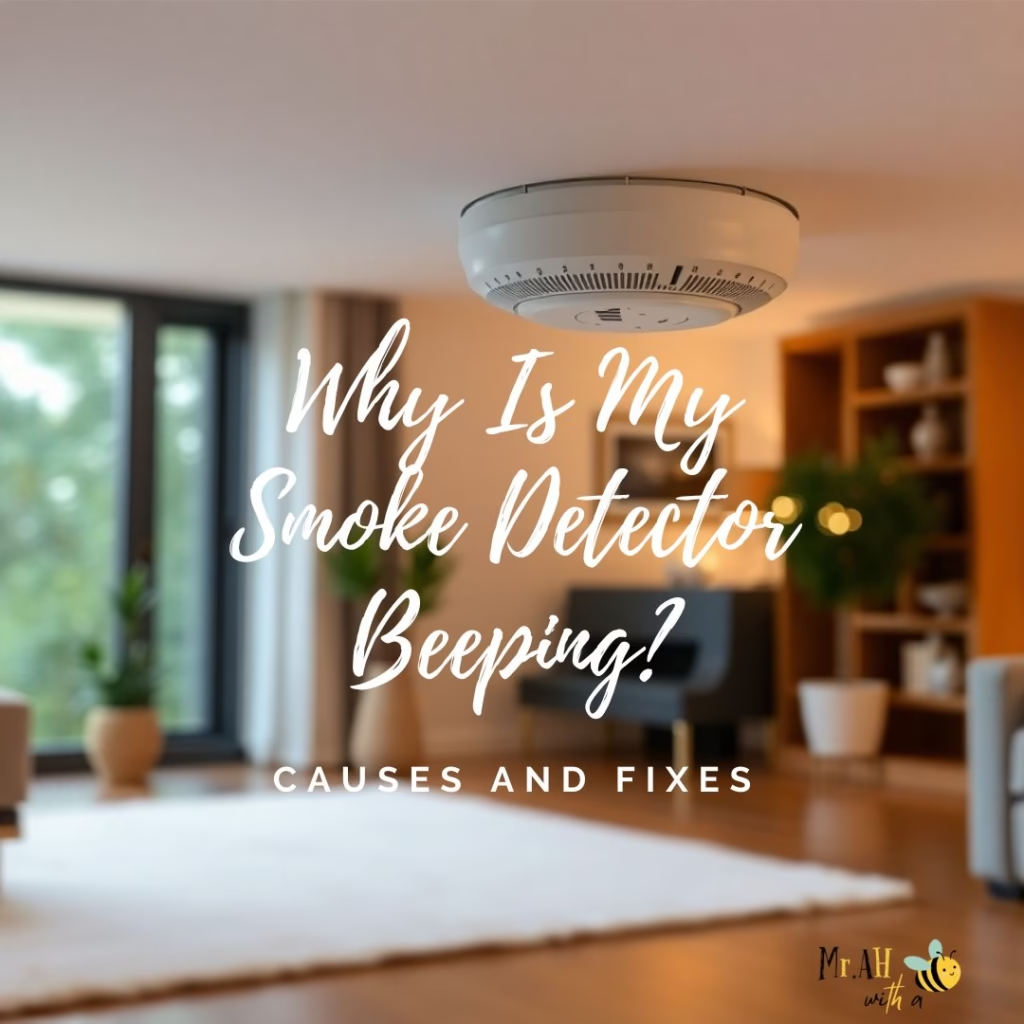Smoke detectors are essential for ensuring home safety, providing crucial alerts about potential fire hazards. These devices play a key role in protecting your family and property by detecting smoke and enabling timely responses to emergencies. However, when smoke detectors emit persistent beeping, it can be both frustrating and alarming. Many homeowners find themselves asking, “why is my smoke detector beeping?” This continuous sound often indicates underlying issues that require immediate attention, such as low batteries, malfunctioning sensors, or even the presence of smoke. Ignoring these warnings can compromise safety, so it’s important to address any beeping promptly and understand what it signifies. Regular maintenance and knowledge of your smoke detector’s alerts can help ensure your home remains a safe environment.
Understanding Smoke Detectors
A smoke detector is an electronic device designed for fire protection that automatically detects smoke—an early sign of fire—and alerts occupants with a warning signal. In commercial and industrial settings, smoke detectors communicate with a fire alarm control panel as part of a centralized fire alarm system. Legally, all workplaces are required to have a smoke detection system in place.
Household smoke detectors, commonly known as smoke alarms, provide audible and/or visual alerts directly from the unit. They can be standalone battery-operated devices or interconnected hardwired systems that are mainly powered and supported by battery backup. The latter type must be installed in all new constructions and during significant renovations.
How They Work
You may be curious about the necessity for different types of smoke detectors. The reason lies in the diverse characteristics of fires. Fires can vary significantly in their heat levels and the types of smoke they produce, depending on the materials involved. For instance, some fires generate fast-burning flames that create thick smoke, while others smolder and produce dense, toxic fumes.
Having a variety of smoke detector types allows for the detection of these differences, enhancing safety in your home or workplace. By incorporating multiple types of detectors—such as ionization and photoelectric alarms—you increase the likelihood of early detection, regardless of the fire’s source or behavior. This proactive approach is crucial for protecting lives and property, ensuring that you are alerted as quickly as possible in case of a fire emergency.
Ionization Detectors


Ionization detectors are designed to identify fast-flaming fires by utilizing radioactive particles. These detectors contain a small amount of radioactive material that ionizes the air within a sensing chamber, allowing it to detect changes in ionization levels caused by the rapid combustion of materials. When a fire breaks out, the quick release of smoke particles disrupts the ion flow, triggering the alarm. Ionization detectors are particularly effective for detecting fires fueled by flammable liquids, paper, and other fast-burning materials, making them an important choice for areas where such risks are prevalent.
Photoelectric Detectors


Photoelectric detectors, on the other hand, are specifically engineered to respond to slow, smoldering fires, utilizing light sensors to detect smoke. These detectors work by projecting a beam of light into a sensing chamber. When smoke enters the chamber, it scatters the light, which is then detected by the sensor. This type of smoke detector is highly effective for identifying fires that produce large smoke particles, such as those generated by burning upholstery or electrical wiring. Because they can sense smoke before flames erupt, photoelectric detectors are valuable for early warning in residential and commercial settings, especially in areas where smoldering fires are more likely to occur.
Combination ionization and photoelectric
To ensure an alarm system that is equally responsive to both smoldering fires and fast-flaming fires, consider investing in a smoke alarm equipped with dual sensors. These advanced alarms incorporate both an ionization sensor and a photoelectric sensor, allowing them to detect a wider range of fire types effectively.
The ionization sensor is adept at identifying fast-burning fires, which produce quick bursts of flames and less dense smoke. In contrast, the photoelectric sensor excels at detecting slow, smoldering fires that generate larger smoke particles and can linger unnoticed for some time. By combining these two technologies, dual-sensor alarms provide comprehensive coverage, enhancing safety in your home or workplace.
Key Components
Power Source: Battery or Hardwired Connection
Smoke detectors can be powered in one of two ways: battery-operated or hardwired. Battery-operated models offer the advantage of easy installation and flexibility in placement, as they do not require electrical wiring. However, it’s crucial to regularly check and replace the batteries to ensure the alarm functions properly. On the other hand, hardwired smoke detectors are directly connected to your home’s electrical system. These devices often come with a battery backup, ensuring they remain operational even during power outages. While installation may be more complex, hardwired detectors provide a reliable, long-term solution for continuous monitoring.
Sensor Chamber
The sensor chamber is a critical component of any smoke detector, as it is where the detection process takes place. This chamber houses the sensors—either ionization or photoelectric—that identify smoke particles in the air. In ionization detectors, the chamber uses radioactive particles to create ionization in the air, allowing it to sense fast-burning fires. In photoelectric detectors, the chamber contains a light source that detects smoke through light scattering. The effectiveness of the sensor chamber directly impacts the alarm’s ability to respond to different types of fires, making it essential for ensuring safety.
Alarm System
The alarm system is the final line of defense in a smoke detection setup. When the sensor chamber detects smoke, it triggers the alarm system to sound a loud warning, alerting occupants to the potential danger. Alarm systems can vary in their features, with some offering additional functionalities such as visual alerts, smart home integration, or connectivity to a central monitoring system. These enhancements can provide not only immediate alerts but also the ability to notify emergency services if needed. A well-designed alarm system is crucial for ensuring that everyone in the vicinity is promptly informed and can take appropriate action in the event of a fire.
Common Reasons for “Why Is My Smoke Detector Beeping”
Low Battery
When the battery in a smoke detector is running low, it will emit a chirping sound at intervals of every 30 to 60 seconds. This beeping serves as an important reminder to replace the battery, ensuring that the detector remains operational. Ignoring this alert can lead to the device becoming inactive, increasing the risk of undetected smoke or fire hazards.
Smoke or Fire Detection
A continuous beeping sound from the smoke detector indicates that it has detected smoke or fire in the vicinity. This persistent alarm is a critical warning that requires immediate attention. It is essential to check the area for signs of smoke or flames and to evacuate if necessary, as this alert can be vital for ensuring safety.
Malfunction
Smoke detectors can occasionally sound false alarms due to internal malfunctions. These issues may stem from electrical faults, sensor failures, or software glitches. For example, a faulty sensor might misinterpret steam or temperature changes as smoke, triggering an alarm without any real threat. Over time, components like battery connections or circuit boards can degrade, leading to erratic behavior. Frequent false alarms can cause alarm fatigue, where occupants ignore genuine alerts.
To resolve a malfunction, homeowners should first reset the detector and clean it to remove any dust or debris affecting the sensor. If problems persist, replacing the unit is recommended to ensure reliable fire detection and maintain safety. Regular maintenance and testing can help prevent malfunctions and ensure effective operation.
Dust or Debris
Dust and debris can significantly affect the performance of smoke detectors, leading to false alarms or unnecessary beeping. Over time, particles can accumulate inside the detector, obstructing the sensors that detect smoke. This buildup can prevent the device from accurately recognizing legitimate smoke signals.
Ionization smoke detectors, which rely on ionized air particles, are particularly susceptible to dust. It can disrupt the flow of ions and cause malfunctions. Similarly, photoelectric detectors can be compromised if dust blocks the light beam, hindering their ability to function properly.
To maintain effectiveness, it’s crucial to regularly clean smoke detectors. Homeowners should gently vacuum the exterior and use a soft brush to remove dust from the sensor openings. Regular maintenance not only enhances performance but also ensures reliable alerts in case of a fire, ultimately protecting lives and property. If beeping persists despite cleaning, it may indicate a deeper issue requiring replacement.
End-of-Life Signal
Smoke detectors generally have a lifespan of 8 to 10 years. When they reach the end of their life, they will typically emit a distinct beeping signal to indicate that replacement is necessary. This alert is crucial, as an expired smoke detector may not function effectively in the event of a fire. It’s important to replace smoke detectors according to their lifespan to ensure ongoing safety in your home.
What to Do When Your Smoke Detector Beeps
Immediate Actions
If you detect smoke or fire, your first priority should be to evacuate the premises immediately. Ensure that everyone in the building is aware of the situation and leaves quickly and safely. Once you are at a safe distance, call emergency services to report the fire, providing them with as much detail as possible about the location and severity of the situation. Do not attempt to investigate the source of the smoke or fire yourself, as this could put you and others at risk.
Troubleshooting Steps
After ensuring everyone’s safety, if the smoke detector is beeping or malfunctioning, follow these troubleshooting steps to address the issue:
- Replace the Battery: A weak battery can often cause alarms to beep. Remove the old battery and replace it with a new one, ensuring it is installed correctly.
- Reset the Detector: To reset the smoke detector, press and hold the test button for approximately 20 seconds. This action can clear any temporary faults in the system and stop false alarms.
-
Clean the Unit: Dust and debris can interfere with the sensor’s functionality. Carefully clean the exterior of the smoke detector using a soft cloth or a vacuum with a brush attachment. Pay special attention to the sensor openings to ensure they are free from buildup.
Preventive Maintenance Tips
- Monthly: Test alarms to ensure functionality.
- Annually: Replace batteries and clean detectors.
- Regularly: Check manufacturing dates and replace units nearing 10 years old.
Smoke Detector Blinking Red: What It Means
If your smoke detector is blinking red, it typically indicates a specific issue that requires your attention. Here are the common reasons for a red blinking light:
- Normal Operation: Some smoke detectors blink red as part of their normal operation, indicating that they are powered on and functioning correctly. This is often seen in models that have a green light for normal operation and a red light for alerts.
- Low Battery: A red blinking light may signal that the battery is low and needs to be replaced. If you observe this behavior, it’s important to replace the battery promptly to ensure the detector remains functional.
- Smoke Detection: A consistent red light (rather than a blinking one) may indicate that smoke has been detected. In this case, the alarm should sound, and you should take immediate action by evacuating the area and calling emergency services.
- Malfunction: If the smoke detector is blinking red and not responding to smoke or low battery conditions, it may indicate a malfunction. In this situation, consult the user manual for troubleshooting steps or consider replacing the unit.
-
End of Life: Many smoke detectors have a lifespan of 8 to 10 years. If the red light is blinking periodically, it could indicate that the unit has reached the end of its life and needs to be replaced.
What to Do
- Check the Manual: Refer to the smoke detector’s user manual for specific meanings associated with the red blinking light.
- Replace the Battery: If a low battery is indicated, replace it immediately.
- Test the Unit: Press the test button to ensure the detector is functioning properly.
- Replace the Detector: If the unit is old or continues to malfunction, consider replacing it for your safety.
Conclusion
In summary, smoke detectors are crucial for maintaining home safety by providing early warnings about potential fire hazards. Understanding their functionality and the reasons behind alerts, such as persistent beeping, is essential for effective fire protection—especially when homeowners find themselves asking, “why is my smoke detector beeping?”
Immediate actions, such as evacuating and contacting emergency services, are vital when smoke or fire is detected. Regular maintenance, including battery replacement, cleaning, and testing, ensures that smoke detectors operate effectively. Additionally, being aware of the specific types of detectors—ionization, photoelectric, or dual-sensor—can enhance your home’s fire safety measures. By taking proactive steps and responding promptly to alarms, you can significantly reduce the risk of fire-related emergencies and protect your loved ones and property.
FAQs
- Why is my smoke detector beeping?
Low battery, sensor issues, or an expired unit may cause beeping. - How do I stop the beeping?
Replace the battery, clean the unit, or reset it. - Why is my smoke detector beeping continuously?
It signals smoke, fire, or an urgent fault. - Can I silence the detector temporarily?
Yes, but only after ensuring there’s no fire. - How long do smoke detectors last?
Typically 8–10 years. - Why does my hardwired detector beep?
It may need a backup battery replacement or have a wiring issue. - How often should I test my smoke detectors?
Test them monthly for reliability. - What’s the difference between chirping and beeping?
Chirping is often a low-battery alert; beeping is more urgent. - Can dust cause beeping?
Yes, it can obstruct sensors and cause malfunctions. - Should I replace all detectors at once?
Yes, if they’re the same age or nearing expiry.
If you like this post you may also like
Thanks for reading, for more interesting articles, visit our homepage.







Pingback: Cheetah vs Leopard Print: How to Spot the Difference